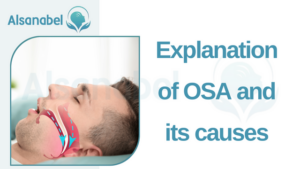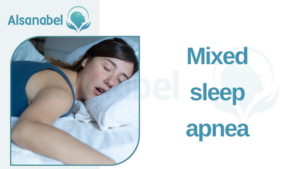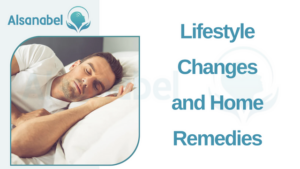Understanding Sleep Apnea Symptoms and Treatments 2023
- Category ADHD
Table of Contents
ToggleIntroduction to Sleep Apnea
Sleep apnea is a type of sleep-related breathing disorder that affects millions of people worldwide. It is characterized by abnormal breathing patterns during sleep, causing periods of interrupted breathing or complete cessation of breath. This condition can have serious health implications if left untreated, so it is essential to understand its symptoms and available treatments.
It is a common sleep disorder, with estimates suggesting that it affects around 25% of adults. It can occur in people of all ages, although it is more prevalent in older individuals and those who are overweight. Sleep apnea is often undiagnosed or misdiagnosed, as its symptoms are often mistaken for other conditions or simply overlooked.
Explanation of OSA and its causes
Obstructive Sleep Apnea (OSA) is the most common form of sleep apnea, affecting millions of individuals worldwide. It occurs when the throat muscles relax and block the airway during sleep. This obstruction leads to episodes of interrupted breathing or complete cessation of breath.

The primary cause of OSA is the relaxation of muscles in the throat and tongue, which tend to collapse and block the airway. Certain factors can increase the risk of developing OSA, such as obesity, a large neck circumference, anatomical abnormalities, and family history.
Common symptoms of OSA
The symptoms of OSA can significantly impact sleep quality and overall well-being. Common symptoms include excessive daytime sleepiness, loud snoring, observed episodes of stopped breathing during sleep, waking during the night gasping or choking, and morning headaches.
Excessive daytime sleepiness can lead to difficulties in concentration, memory problems, and a decreased ability to perform daily activities. The interrupted breathing episodes can also disrupt a person’s sleep, leading to poor-quality sleep, frequent awakenings, and an overall feeling of restlessness.
If left untreated, OSA can have serious health implications, including an increased risk of cardiovascular diseases, high blood pressure, diabetes, stroke, and obesity-related complications.
Treatment options for OSA
Fortunately, there are various treatment options available for individuals with OSA. The choice of treatment depends on the severity of the condition and individual circumstances.
- One common treatment is a continuous positive airway pressure (CPAP) device, which uses positive pressure to keep the airway open during sleep. This treatment involves wearing a mask over the nose or mouth that delivers a constant flow of air. CPAP therapy is highly effective in reducing the symptoms of OSA and improving sleep quality.
- Another option is the use of oral appliances or mouthpieces, which thrust the lower jaw forward during sleep. These devices help keep the airway open and can be an effective treatment for mild to moderate OSA.
- In some cases, lifestyle changes like weight loss, avoiding alcohol and sedatives, or sleeping on the side can also help improve OSA symptoms.
- For severe or persistent cases of OSA, surgery may be considered. Surgical procedures aim to remove or alter the tissues that are obstructing the airway, making it easier to breathe during sleep.
If you suspect you may have OSA, it is crucial to consult a healthcare professional who can evaluate your symptoms and recommend the most suitable treatment options for your specific needs. Managing OSA effectively can lead to improved sleep quality, enhanced daytime functioning, and better overall health and well-being.
Central Sleep Apnea (CSA)
Central Sleep Apnea (CSA) is a less common form of sleep apnea as compared to Obstructive Sleep Apnea (OSA). While OSA is mainly caused by physical blockage of the airway, CSA is characterized by a lack of drive to breathe during sleep. This results in insufficient or absent ventilation and compromised gas exchange.
Unlike OSA, which occurs due to relaxed throat muscles, CSA is caused by a malfunction in the brain’s respiratory control system. The brain fails to send proper signals to the muscles responsible for breathing, leading to interrupted or shallow breathing during sleep.
CSA can be primary, meaning it occurs on its own without any underlying cause, or secondary, occurring as a result of another medical condition. Conditions such as heart failure, stroke, certain medications, and even high altitudes can contribute to the development of CSA.
Signs, symptoms and effects
CSA symptoms are often first noticed by bed partners, caregivers, or loved ones. Abnormal breathing patterns during sleep may include brief cycles of rapid, shallow, or even paused breathing. Individuals with CSA may experience frequent awakenings, disturbed sleep, and excessive daytime sleepiness.
The inadequate ventilation during sleep can have detrimental effects on overall health. The lack of oxygen intake can lead to poor concentration, memory problems, and decreased ability to perform daily activities. The disrupted sleep can also result in fatigue, mood changes, and an increased risk of accidents.
If left untreated, CSA can have significant health implications. It can contribute to an increased risk of cardiovascular diseases, such as high blood pressure, heart arrhythmias, and even heart failure. Proper diagnosis and treatment are essential to managing CSA and improving overall health outcomes.
Treatment options for CSA may involve addressing the underlying medical condition if present. In some cases, positive airway pressure (PAP) machines, similar to those used in OSA, may be utilized to help improve ventilation during sleep. Medications or oxygen therapy may also be prescribed to assist with breathing.
Consulting a healthcare professional is crucial for accurate diagnosis and individualized treatment plans. Managing CSA effectively can lead to improved sleep quality, enhanced daytime functioning, and better overall health and well-being.
Mixed sleep apnea
Mixed sleep apnea is a unique type of sleep apnea that combines both obstructive sleep apnea (OSA) and central sleep apnea (CSA). Mixed sleep apnea presents with symptoms from both OSA and CSA, making it important to recognize its distinguishing features.

Combination of symptoms
Individuals with mixed sleep apnea may experience a combination of symptoms from both OSA and CSA. Common symptoms include loud snoring, pauses in breathing during sleep, excessive daytime sleepiness, morning headaches, difficulty concentrating, and fatigue. These symptoms can significantly impact an individual’s quality of life and overall health.
When it comes to treating mixed sleep apnea, a comprehensive approach is necessary. The primary treatment option for mixed sleep apnea is continuous positive airway pressure (CPAP) therapy. CPAP helps maintain an open airway and provides a steady flow of air to prevent both the physical blockage seen in OSA and the lack of drive to breathe in CSA. By consistently using CPAP therapy, the symptoms of mixed sleep apnea can be effectively managed.
It is important to note that treating obstructive sleep apnea initially with CPAP therapy may cause a condition known as complex sleep apnea or treatment-emergent central sleep apnea in rare cases. Complex sleep apnea occurs when the use of CPAP triggers the development of central sleep apnea symptoms. If this occurs, alternative treatment options such as adaptive servo-ventilation may be considered.
To ensure proper diagnosis and individualized treatment plans, it is crucial to consult with a healthcare professional experienced in sleep disorders. They can assess the specific symptoms, perform diagnostic tests, and recommend the most appropriate treatment options for managing mixed sleep apnea effectively. With proper treatment, individuals with mixed sleep apnea can experience improved sleep quality, enhanced daytime functioning, and better overall health and well-being.
Diagnosing Sleep Apnea
When it comes to diagnosing sleep apnea, healthcare professionals rely on various methods and procedures to accurately assess and confirm the condition. If someone presents with symptoms suggestive of sleep apnea, the physician will likely recommend undergoing testing to determine the presence and severity of the disorder.
The most common tests for diagnosing sleep apnea include:
- Medical History Assessment: Healthcare professionals will start by taking a detailed medical history, which involves asking about symptoms, their severity, and the duration of the symptoms. A thorough medical history can provide valuable information about the possible presence of sleep apnea and help determine the appropriate diagnostic tests.
- Physical Examination: During a physical examination, the healthcare provider will check for any physical characteristics that may contribute to sleep apnea, such as obesity, a narrow airway, or enlarged tonsils. These physical findings, along with the patient’s symptoms, can help guide the diagnostic process.
- Sleep Study (Polysomnography): The gold standard test for diagnosing sleep apnea is a sleep study, also known as polysomnography. This test is usually conducted during an overnight stay at a specialized sleep laboratory. It involves the placement of various sensors and electrodes on the patient’s body to monitor their sleep stages, brain waves, eye movements, heart rate, breathing patterns, and oxygen levels. This comprehensive assessment allows healthcare professionals to identify any disruptions in breathing patterns and accurately diagnose obstructive or central sleep apnea.
- Home Sleep Apnea Testing: In some cases, healthcare professionals may recommend a home sleep apnea test as an alternative to a sleep study. This test involves wearing a portable monitoring device at home, which records specific measurements such as breathing patterns, oxygen levels, and heart rate. While a home sleep apnea test may be more convenient, it may not provide as comprehensive data as a polysomnography performed in a sleep laboratory.
Significance of sleep studies and other diagnostic tests
Sleep studies, whether conducted in a sleep laboratory or at home, are crucial in diagnosing sleep apnea accurately. These diagnostic tests provide essential information about an individual’s sleep patterns, breathing abnormalities, and other factors that contribute to the condition. By identifying the presence and severity of sleep apnea, healthcare professionals can develop tailored treatment plans to address the specific needs of each individual.
In addition to sleep studies, healthcare professionals may also recommend other diagnostic tests, such as:
- Imaging tests: Imaging tests, such as X-rays or CT scans, can help identify any anatomical abnormalities that may contribute to sleep apnea, such as a deviated septum or enlarged adenoids or tonsils.
- Multiple Sleep Latency Test (MSLT): MSLT is a daytime test that measures how quickly an individual falls asleep in a quiet environment during the day. It is often used to diagnose conditions such as narcolepsy and assess daytime sleepiness associated with sleep apnea.
Understanding sleep apnea symptoms and diagnosing the condition accurately are crucial in formulating effective treatment plans. By utilizing these diagnostic methods and tests, healthcare professionals can provide personalized care and guidance for managing it and improving sleep quality and overall well-being.
Conventional Treatments
Sleep apnea is a serious condition that requires proper management to improve sleep quality and overall well-being. There are several conventional treatments available that can ultimately reduce or even eliminate sleep apnea’s effects on your life for as long as you use these treatments. Let’s take a look at some of the common treatments for it and assess their effectiveness.
Overview of CPAP therapy and its effectiveness
Positive airway pressure (PAP) therapy is considered the gold standard treatment. The most well-known form of PAP therapy is Continuous Positive Airway Pressure (CPAP), which involves wearing a mask over the nose or mouth during sleep. This mask is connected to a machine that delivers a constant stream of air pressure, keeping the airway open and preventing apneas and hypopneas.
Studies have shown that CPAP therapy is highly effective in treating sleep apnea. It can significantly reduce and, in some cases, completely eliminate snoring, daytime sleepiness, and other symptoms associated with sleep apnea. However, adherence to CPAP therapy can be challenging for some individuals, as wearing a mask throughout the night can be uncomfortable or cause feelings of claustrophobia. Fortunately, there are alternative treatments available for those who cannot tolerate CPAP therapy.
Other common treatments
Oral appliances, also known as mouthpieces, are another option. These devices are custom-made by dentists and work by repositioning the jaw and tongue to keep the airway open during sleep. Oral appliances are often recommended for individuals with mild to moderate sleep apnea or for those who cannot tolerate CPAP therapy. While they may not be as effective as CPAP in severe cases, studies have shown that oral appliances can still improve symptoms and quality of life.
Surgery may be considered for sleep apnea treatment in certain cases when other treatments have not been successful. Surgical options aim to physically remove excess tissue or correct anatomical abnormalities that are blocking the airway. However, surgery is generally considered a last resort and is not suitable for everyone. It is important to discuss the potential risks and benefits with a healthcare professional before considering surgical options.
In addition to these treatments, lifestyle modifications such as weight loss, regular exercise, and avoiding alcohol and sedatives can also help improve sleep apnea symptoms. These lifestyle changes can be particularly effective for individuals with mild to moderate sleep apnea.
Lifestyle Changes and Home Remedies
Developing and maintaining healthy sleep habits is crucial for managing sleep apnea. By making certain lifestyle changes and implementing home remedies, individuals can significantly improve their sleep quality and reduce the severity of symptoms.

One key aspect of managing it is maintaining a regular sleep schedule. Going to bed and waking up at the same time every day helps regulate the body’s internal clock and promotes better sleep. Creating a relaxing bedtime routine can also signal to the body that it’s time to wind down and prepare for sleep.
Sleeping in a good sleep environment can make a big difference as well. It’s important to keep the bedroom cool, dark, and quiet, as these conditions promote optimal sleep. Removing electronic devices, such as smartphones and tablets, from the bedroom can also help create a more sleep-friendly environment.
Natural remedies and lifestyle modifications
Maintaining a healthy weight is particularly important, as excess weight can contribute to the narrowing of the airway. Engaging in regular physical activity and following a balanced diet can aid in weight management and improve overall sleep apnea symptoms.
Avoiding alcohol and sedatives, especially close to bedtime, is also recommended. These substances can relax the muscles in the throat, which can worsen sleep apnea symptoms. Sticking to non-alcoholic beverages and consulting with a healthcare professional about alternative medications can help reduce the impact of these substances on sleep.
Sleeping on your side instead of your back can also help prevent the collapse of the airway during sleep. Using pillows or other devices to encourage side sleeping can be beneficial for individuals with sleep apnea.
While these lifestyle changes and home remedies can be effective for managing mild to moderate sleep apnea, it’s important to consult with a healthcare professional for an accurate diagnosis and appropriate treatment plan. They can provide personalized guidance and recommend any necessary medical interventions or devices to improve sleep apnea symptoms.
Surgical Options
When lifestyle changes, home remedies, and non-invasive treatments fail to effectively manage sleep apnea, surgical options can be considered. There are several surgical procedures available for treating sleep apnea, each with its own risks and benefits.
One common surgical intervention is uvulopalatopharyngoplasty (UPPP), which involves removing excess tissue from the throat, including the uvula, tonsils, and part of the soft palate. This procedure aims to widen the airway and reduce sleep apnea symptoms. Another surgical option is genioglossus advancement, where the bone in the lower part of the jaw is modified to move the tongue and prevent it from blocking the airway during sleep.
Maxillomandibular advancement is a more extensive surgical procedure that repositions the upper and lower jaws forward, increasing the size of the airway. This surgery is typically recommended for individuals with severe sleep apnea or skeletal abnormalities that contribute to airway obstruction.
Less invasive surgical options include radiofrequency ablation, which uses energy waves to shrink and stiffen tissues in the throat, and hypoglossal nerve stimulation, which involves implanting a device that stimulates the nerves controlling the tongue muscles to prevent airway collapse.
Considerations and potential risks of surgical interventions
While surgical interventions can be effective in improving sleep apnea symptoms, it is important to carefully consider the potential risks and benefits before deciding on surgery. Risks associated with sleep apnea surgery include bleeding, infection, pain, complications from anesthesia, and a longer recovery period.
It is essential to have a comprehensive evaluation by a sleep specialist or surgeon to determine if surgery is the right option for you. Factors such as the severity of sleep apnea, the specific anatomical abnormalities causing the airway obstruction, and any underlying medical conditions should be taken into account.
In conclusion, surgical treatment can be considered once a patient has failed CPAP therapy despite counseling and correction of common CPAP issues. There are various surgical modalities available for the treatment of sleep apnea, and the choice of procedure should be made in consultation with a healthcare professional. It is important to weigh the potential risks and benefits and have realistic expectations about the outcomes of sleep apnea surgery.









